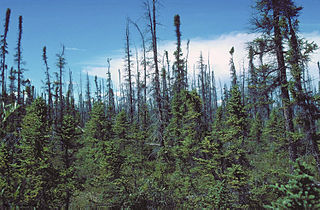Related Research Articles

The Anatidae are the biological family of water birds that includes ducks, geese, and swans. The family has a cosmopolitan distribution, occurring on all the world's continents except Antarctica. These birds are adapted for swimming, floating on the water surface, and in some cases diving in at least shallow water. The family contains around 174 species in 43 genera.

The diving ducks, commonly called pochards or scaups, are a category of duck which feed by diving beneath the surface of the water. They are part of Anatidae, the diverse and very large family that includes ducks, geese, and swans.

The boreal forest or taiga of the North American continent stretches through a majority of Canada and most of central Alaska, extending spottily into the beginning of the Rocky Mountain range in Northern Montana and into New England and the Adirondack Mountains of New York. This habitat extends as far north as the tree line and discontinues in mixed deciduous-coniferous forests to the south. The "taiga", as it is called there, of Eurasia occupies a similar range on those continents. Throughout the Northern Hemisphere, the boreal forest covers 2.3 million square miles, a larger area than the remaining Brazilian Amazon rain forest. Although it is largely forest, the boreal forests include a network of lakes, river valleys, wetlands, peat lands and semi-open tundra.
This is a list of the fauna of Finland. Finland borders Sweden to the west, Russia to the east, and Norway to the north, while Estonia lies to its south across the Gulf of Finland, allowing an ecological mix. Finland contains many species of mammals, birds, and fish, but only a few reptiles and amphibians. This article discusses all the vertebrate animals which can be found on Finland itself, not the oceans.

Upper and Lower Black Moss Reservoirs are reservoirs close to the village of Barley, in the Borough of Pendle, close to the market town of Burnley, England. The reservoirs provide drinking water to Nelson when needed.
The Chhilchhila Wildlife Sanctuary, also known as Seonthi Reserve Forest, is located near Kurukshetra University in Kurukshetra district in the Indian state of Haryana. Baba Rodanath Dera temple is on the periphery of the Chhilchhila Sanctuary.

Faunia is a zoo and a botanical garden located in Madrid, Spain. It covers about fourteen square hectares and is organized into areas representing different ecosystems, such as jungle, polar regions, and African forest. It is owned by Parques Reunidos, SA.
The Nicolet Bird sanctuary is a protected area in Quebec and one of the 28 migratory bird sanctuary of that province. This refuge protects a migratory halt for duck and Canada goose and also a nesting area for waterfowl. It is located a few kilometers west of Nicolet on the south shore of Lake Saint Pierre.
Hail Haor Wildlife Sanctuary is a major wildlife sanctuary in Bangladesh. It is one of the most important wetlands in the Sylhet Basin for the resident and migratory waterfowls. It is also important watersource for the inhabitants living around when all other sources dry up during summer. The sanctuary is located in Moulvibazar District, in the northeast region of the country.
References
- ↑ "Tyzzeria (Genus)". wildlife1.wildlifeinformation.org. Archived from the original on 2007-08-27.
- ↑ Allen EA (1936) Tyzzeria perniciosagen. etsp. nov., a coccidium from the small intestine of Pekin Duck, Anas domesticus L. Archiv für Protistenkunde 87, 262-267